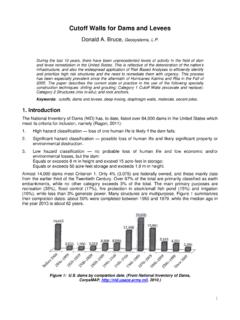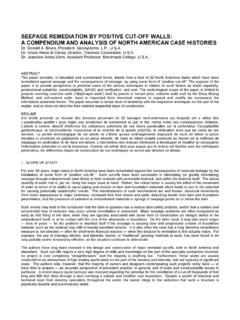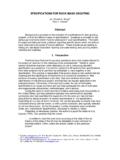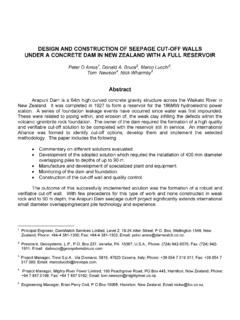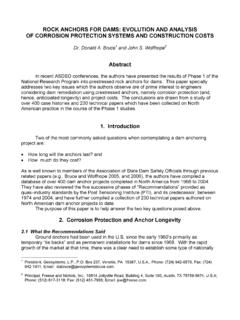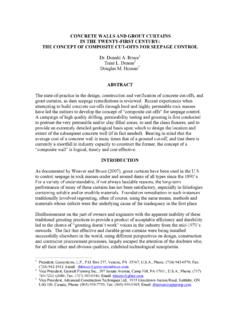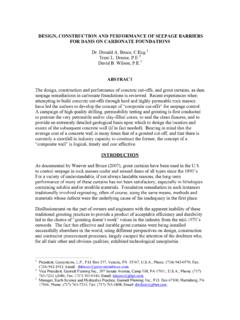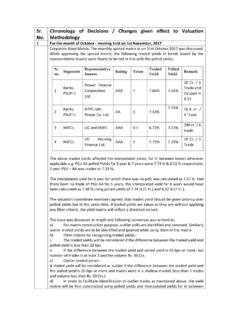Transcription of 40 Years of Rock Anchors for Dams in the US
1 40 years of rock anchors for DAMS IN NORTH AMERICA LESSONS LEARNED Dr. Donald A. Bruce1 John S. Wolfhope, ABSTRACT Over the last few Years , the authors have acted as Co-Principal Investigators on a National Research Program on Rock Anchors for Dams. Three main tasks have been accomplished, leading to the development of a comprehensive database: (i) comparative analysis of the five successive sets of recommendations governing practice (1974-2004); (ii) compilation of over 230 technical papers describing North American case histories; and (iii) development of details of over 400 projects executed on North American dams. As a result, the authors are able now to provide a historical perspective to the art and science as it has evolved over the Years . Technical guidance is provided on the key areas of design, corrosion protection, and construction practices. Cost information is also supplied as a first stage in project cost estimation. EVOLUTION OF AMERICAN PRACTICE Permanent post-tensioned rock Anchors have been used in North America for more than 40 Years .
2 Although there are early documented cases of dam anchoring in North Africa in the 1930 s, the first North American projects did not occur until the mid 1960 s when the practice was adopted by the Army Corps of Engineers (USACE) and Montana Power Company. Two notable early projects include John Hollis Bankhead Lock & Dam in 1965 and Little Goose Locks & Dam in 1968. The evolution of the Recommendation documents has had a very strong influence on North American anchoring practice. Recognizing the need for some type of national guidance and uniformity, tentative recommendations of practice for pre-stressed rock and soil Anchors were first issued by the Post-Tensioning Division of the Prestressed Concrete Institute (PCI) in 1974. The Post-Tensioning Division of PCI formed an independent organization known as the Post-Tensioning Institute in 1976. In 1980, the Post-Tensioning Institute issued the First Edition of Recommendations for Prestressed Rock and Soil Anchors (PTI Recommendations) that were subsequently adopted and reprinted by the USACE.
3 Successive editions of the PTI Recommendations were issued in 1986, _____ 1 President, Geosystems, , Box 237, Venetia, PA 15367, ; Phone: (724) 942-0570; Fax: (724) 942-1911; Email: 2 Principal, Freese and Nichols, Inc., 10814 Jollyville Road, Building 4, Suite 100, Austin, TX 78759-5674, ; Phone: (512) 617-3118; Fax: (512) 451-7956; Email: 1996, and 2004. A review of the successive recommendation documents reveals a clear evolution from promotional literature documenting case studies of projects to detailed guidance and commentary information on the primary areas of anchoring practice: Materials, Design, Corrosion Protection, Construction, and Stressing/Testing. More detailed analysis of the evolution of the PTI Recommendations may be found in Bruce and Wolfhope (2007a). The early projects were performed by post-tensioning specialists from the building and transportation industries teamed up with drilling contractors to perform the required drilling and grouting.
4 Although the fundamental design practices for the sizing of the bond zone and load transfer have not changed substantially over 40 Years of practice, review of the early projects reveals that corrosion protection practices were inadequate until the 1990 s. The early projects relied solely on grout cover around the prestressing steel to provide corrosion protection; it is now recognized that the grout in the bond zone crushes locally during stressing and testing and can provide seepage contact with the steel. Analysis of an isolated early project reveals evidence of tendon failure at the top of the bond zone after as little as 10 Years of service in foundation conditions prone to water movement, providing confirmation of corrosion protection breakdown in the region of the highest grout to rock bond stresses. Although the use of plastic corrugated sheathing and epoxy coating is mentioned as available options in the 1980 PTI Recommendations, the use of an impermeable encapsulation was not prescribed until the 1986 PTI Recommendations.
5 Overall, between 1974 and 2006 extremely sophisticated corrosion protection systems were developed and the latitude offered to designers relative to the choice of corrosion protection intensity and details was severely restricted. The most recent 2004 edition provides a detailed coverage of corrosion protection practices including the use of corrugated plastic encapsulation over the full length of the anchor tendon and a separate supplement dealing with the specifications, materials, design, construction, and testing for the use of epoxy coated and filled strand. To install a permanent anchor in a dam without Class I (encapsulated tendon) protection is now not only impermissible, but unthinkable. Table below, taken from the 2004 edition of the PTI Recommendations, provides the requirements for Class I corrosion protection. Table 1 Corrosion Protection Requirements (taken from PTI Recommendations 2004) CORROSION PROTECTION REQUIREMENTS CLASS ANCHORAGE FREE STRESSING LENGTH TENDON BOND LENGTH 1 ENCAPSULATED TENDON Trumpet Cover if exposed Corrosion inhibiting compound-filled sheath encased in grout , or Grout-filled sheath, or Grout-encased epoxy-coated strand in a successfully water-pressure tested drill hole Grout-filled encapsulation, or Epoxy-coated strand tendon in a successfully water-pressure tested drill hole II GROUT PROTECTED TENDON Trumpet Cover if exposed Corrosion inhibiting compound-filled sheath encased in grout, or Grout-encased epoxy-coated bar tendon, or Polyester resin for fully bonded bar tendons in sound rock with non-aggressive ground water Grout Polyester resin in sound rock with non-aggressive ground water It is now considered standard practice that modern prestressed rock anchor systems for dam construction and rehabilitation will provide service lives exceeding 50 Years .
6 Figure 1 and Figure 2 demonstrate the evolution of corrosion protection from bare steel tendons in grout to modern multi-level corrosion protection systems. Figure 1. Bare Steel Multi-Strand Tendon Figure 2. Fully Encapsulated Multi-Strand Tendon Fortunately, the drilling and grouting practices for the early dam anchoring projects were (and remain) conservative with careful attention given to the grouting of the drilled anchor holes prior to tendon installation. The philosophy of pregrouting and redrilling the hole ( waterproofing ) if it were to fail a permeability test was reaffirmed from 1974 onwards: indeed the early pass-fail acceptance criteria were, in fact, very rigorous and led to most Anchors on most projects having to be pregrouted and redrilled several times. Although laudable, this was often, in fact, extra work since the criterion to achieve grout tightness is really much more lax than the criterion needed to provide the specified degree of water tightness.
7 The saving grace of many of the early Anchors was doubtless the overly conservative drill hole waterproofing criterion under which they were constructed. OBSERVATIONS FROM DAM ANCHORING CASE STUDIES As part of the National Research Program (Bruce and Wolfhope 2006) case studies have been developed for the more than 400 dam anchoring projects occurring throughout North America over the past 40 Years . More than five anchoring dam projects have been successfully completed in each of over 25 states and three Canadian provinces, with only 10 states where prestressed tendon Anchors have not been used in dam applications. The case studies have been compiled into a database repository for easy retrieval of information and analysis of statistical information. Although limited information exists on many of the older projects, the case studies for many of the projects from the last decade of practice include details on the anchor systems, corrosion protection, and the engineering aspects of the anchor design.
8 The danger of losing remaining historical information, the original driver for the National Research Program, remains a threat to the full understanding of the evolution of American anchoring practice and the opportunity to improve practice based on lessons learned over 40 Years of practice. It is apparent that the industry has historically been driven by regulatory changes that have resulted in the need for dams to accommodate increased hydrostatic and dynamic loading conditions while maintaining minimum acceptable stability safety factors. The use of prestressed Anchors is often the only practically available option for increasing the sliding and overturning stability of overflow spillways and is typically two to three times less costly than mass concrete stabilization alternatives for non-overflow concrete gravity dams. The use of prestressed Anchors in dams has been well documented in over 230 published journal articles. It can be stated that no documented cases have been reported where a dam that has been anchored has failed.
9 In general the case histories indicate good performance of the anchor systems. There are isolated situations where dams have been anchored multiple times due to poor performance of the Anchors ; these cases are undoubtedly attributable to inappropriate design approaches and construction techniques. Although there are questions as to the long term reliability of the early anchor tendons installed with grout cover as the sole corrosion barrier, the case studies of projects occurring over the past decade reveal the application of systematic design approaches including attention to the corrosion protection and the quality control aspects throughout construction and testing. LESSONS LEARNED OVER 40 Years OF PRACTICE Beyond the overall evolution of North American practice since the 1960 s, significant advances have been made in specific aspects of the use and application of prestressed Anchors for dams. The following sections identify lessons learned from the review of North American anchoring practice regarding design, corrosion protection, and construction practices these being three key areas of anchor technology.
10 Design Aspects The conservative assumption of uniform bond stress distribution at the rock-grout interface remains the standard of practice. The recommended maximum bond stress values for various foundation conditions have remained essentially unchanged in the PTI recommendation documents over 30 Years . This is a conservative state of affairs. The early use of multi-wire tendons has been replaced with the use of multiple seven-wire low-relaxation steel strand tendons since the 1980 s. Multi-strand tendons have been installed in a variety of configurations ranging from low capacity tendons with 2 strands per tendon with a design load of less than 70 kips to high capacity tendons exceeding 90 strands per tendon with lock-off loads approaching 4000 kips. Multi-strand tendon lengths on dam anchoring projects range from as little as 30 feet to over 350 feet. The permissible capacity of the tendon is dictated by the integrity of the dam structure, the strength and uniformity of the foundation, and the configuration of the structural elements of the dam.
